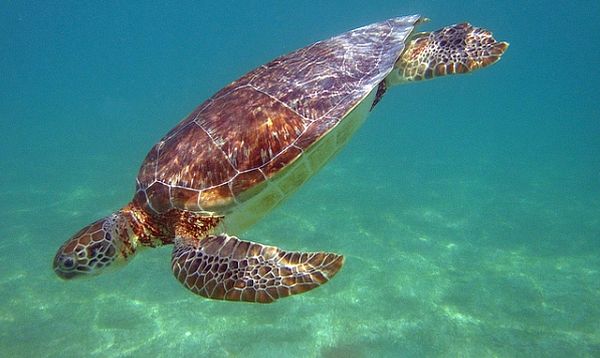Mexico is famous for being the sea turtle capital of the world - a place where people can interact with them along the beautiful coastline. Literally, every sea turtle species on earth nests on Mexicoís beaches, save one that is only found in Australia. That is why the manner in which Mexico protects its sea turtles is important on a global scale.
Current Mexican law classifies all sea turtle species as endangered and protects them from the harvesting of their meat, skin, shell, or eggs. But up until now, the only nesting habitat protected by law are those considered as sanctuaries and reserves.
The good news is that recently, Mexico passed laws offering a whole slate of new protections for sea turtle nesting grounds in the country. The new regulations extend habitat protections to "all" sea turtle nesting sites.
Here are just some of the things that this new and unprecedented regulation has accomplished for sea turtle nesting habitat:
 |
Protecting Native Habitat
The new regulation prohibits the removal of native vegetation within the nesting habitat. When coastal vegetation is removed from the beach and the sand dunes, it allows increased erosion that can eventually destroy nesting habitat. Certain turtles, like the critically endangered hawksbill sea turtle, even prefer to crawl all the way up to the vegetation to nest.
Off-Road Vehicles
Heavy vehicles compact sand, destroying nests and eggs. They also create deep ruts that can become traps for nestlings. Under the new regulations, vehicles on nesting beaches have to weigh less than 660 lbs. and can only be used for patrolling and management of the nesting site.
Removal of Artificial Lights
Artificial lights from houses, hotels, and roads play a large role in the disruption of nesting sea turtles as they not only confuse the female turtles, but they can also be extremely dangerous to emerging hatchlings.
The baby turtles look for the subtle light reflecting off the surf and waves to direct them towards the sea. Artificial lighting can point them in the wrong direction and wandering about leads to almost certain death from predators. Even hatchlings that eventually find their way to the water can be too exhausted to swim - becoming easy pickings for marine birds and fish.
The new regulations call for moving, changing, or eliminating any light sources that illuminate a nesting beach. Authorities are already informing beachside homeowners and hotels of the new rules will soon be checking for compliance.
Spectators
A less obvious activity which threatens sea turtles was also outlawed by the new regulations - the capture and release of newly hatched sea turtles for spectacle.
Many hotels near nesting beaches offer their guests the opportunity to be part of the release of hatchlings into the sea. The problem is that they keep the baby turtles in confinement for several days until enough people sign up for the event and when they are eventually released, often times they are weak from being held in captivity, and are unable to handle the surf or avoid predators.
In is extremely important for them to get into the water as soon as possible to use their limited energy to swim away.
 |
This tourism practice is now forbidden and those who want to watch the turtles lay their eggs and the hatchlings make their way to the sea, will have to follow strict rules.
Further Action Needed
Now that sea turtles are protected on land, itís time to protect them in the ocean. Each year Mexican fisheries kill more than 2,000 endangered loggerheads as they fish for halibut and sharks off their country's coastline. These "bycatch" totals are some of the highest in the world and it is jeopardizing the turtle's survival.
For nearly a decade, scientists have documented high levels of sea turtle entanglement and strandings on Mexico's beaches. Scientists believe Baja California Sur has the highest concentration of sea turtle strandings anywhere in the world as Mexican fisheries overlap with key sea turtle feeding grounds. The turtles get caught up in the fisherman's nets and are dragged along underwater causing them to drown.
The United States has required its fishermen to adopt sea turtle bycatch prevention measures, including closing high-risk fishing areas. But some of these measures, including special nets that reduce the turtle bycatch, are quite expensive and as of yet, Mexico has not taken similar action to curb the problem. Certain conservation groups have formally requested the US government to impose trade sanctions against the country unless they take similar action to limit loggerhead bycatch.
The new Mexican law has taken a huge step forward in creating protections for sea turtle nesting land. Now it is time for them to finish the job and their commitment to the environment by extending that sanctuary into the oceans the turtles use to travel to and from their breeding grounds.
Source: Care2.com


